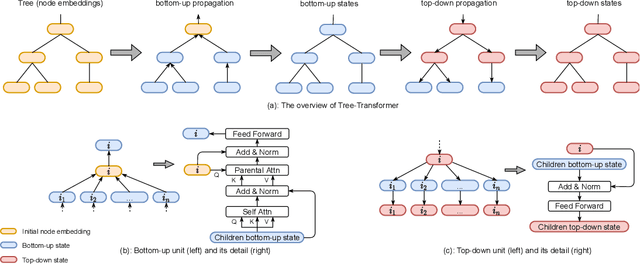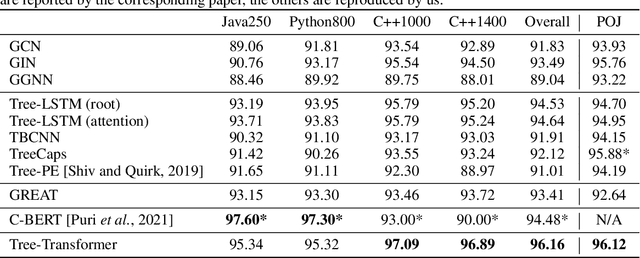Kechi Zhang
SATURN: SAT-based Reinforcement Learning to Unleash Language Model Reasoning
May 22, 2025Abstract:How to design reinforcement learning (RL) tasks that effectively unleash the reasoning capability of large language models (LLMs) remains an open question. Existing RL tasks (e.g., math, programming, and constructing reasoning tasks) suffer from three key limitations: (1) Scalability. They rely heavily on human annotation or expensive LLM synthesis to generate sufficient training data. (2) Verifiability. LLMs' outputs are hard to verify automatically and reliably. (3) Controllable Difficulty. Most tasks lack fine-grained difficulty control, making it hard to train LLMs to develop reasoning ability from easy to hard. To address these limitations, we propose Saturn, a SAT-based RL framework that uses Boolean Satisfiability (SAT) problems to train and evaluate LLM reasoning. Saturn enables scalable task construction, rule-based verification, and precise difficulty control. Saturn designs a curriculum learning pipeline that continuously improves LLMs' reasoning capability by constructing SAT tasks of increasing difficulty and training LLMs from easy to hard. To ensure stable training, we design a principled mechanism to control difficulty transitions. We introduce Saturn-2.6k, a dataset of 2,660 SAT problems with varying difficulty. It supports the evaluation of how LLM reasoning changes with problem difficulty. We apply Saturn to DeepSeek-R1-Distill-Qwen and obtain Saturn-1.5B and Saturn-7B. We achieve several notable results: (1) On SAT problems, Saturn-1.5B and Saturn-7B achieve average pass@3 improvements of +14.0 and +28.1, respectively. (2) On math and programming tasks, Saturn-1.5B and Saturn-7B improve average scores by +4.9 and +1.8 on benchmarks (e.g., AIME, LiveCodeBench). (3) Compared to the state-of-the-art (SOTA) approach in constructing RL tasks, Saturn achieves further improvements of +8.8%. We release the source code, data, and models to support future research.
FANformer: Improving Large Language Models Through Effective Periodicity Modeling
Feb 28, 2025Abstract:Periodicity, as one of the most important basic characteristics, lays the foundation for facilitating structured knowledge acquisition and systematic cognitive processes within human learning paradigms. However, the potential flaws of periodicity modeling in Transformer affect the learning efficiency and establishment of underlying principles from data for large language models (LLMs) built upon it. In this paper, we demonstrate that integrating effective periodicity modeling can improve the learning efficiency and performance of LLMs. We introduce FANformer, which integrates Fourier Analysis Network (FAN) into attention mechanism to achieve efficient periodicity modeling, by modifying the feature projection process of attention mechanism. Extensive experimental results on language modeling show that FANformer consistently outperforms Transformer when scaling up model size and training tokens, underscoring its superior learning efficiency. To further validate the effectiveness of FANformer, we pretrain a FANformer-1B on 1 trillion tokens. FANformer-1B exhibits marked improvements on downstream tasks compared to open-source LLMs with similar model parameters or training tokens. The results position FANformer as an effective and promising architecture for advancing LLMs.
FAN: Fourier Analysis Networks
Oct 03, 2024



Abstract:Despite the remarkable success achieved by neural networks, particularly those represented by MLP and Transformer, we reveal that they exhibit potential flaws in the modeling and reasoning of periodicity, i.e., they tend to memorize the periodic data rather than genuinely understanding the underlying principles of periodicity. However, periodicity is a crucial trait in various forms of reasoning and generalization, underpinning predictability across natural and engineered systems through recurring patterns in observations. In this paper, we propose FAN, a novel network architecture based on Fourier Analysis, which empowers the ability to efficiently model and reason about periodic phenomena. By introducing Fourier Series, the periodicity is naturally integrated into the structure and computational processes of the neural network, thus achieving a more accurate expression and prediction of periodic patterns. As a promising substitute to multi-layer perceptron (MLP), FAN can seamlessly replace MLP in various models with fewer parameters and FLOPs. Through extensive experiments, we demonstrate the effectiveness of FAN in modeling and reasoning about periodic functions, and the superiority and generalizability of FAN across a range of real-world tasks, including symbolic formula representation, time series forecasting, and language modeling.
Self-Edit: Fault-Aware Code Editor for Code Generation
May 06, 2023Abstract:Large language models (LLMs) have demonstrated an impressive ability to generate codes on competitive programming tasks. However, with limited sample numbers, LLMs still suffer from poor accuracy. Inspired by the process of human programming, we propose a generate-and-edit approach that utilizes execution results of the generated code from LLMs to improve the code quality on the competitive programming task. We execute the generated code on the example test case provided in the question and wrap execution results into a supplementary comment. Utilizing this comment as guidance, our fault-aware code editor is employed to correct errors in the generated code. We perform extensive evaluations across two competitive programming datasets with nine different LLMs. Compared to directly generating from LLMs, our approach can improve the average of pass@1 by 89\% on APPS-dev, 31\% on APPS-test, and 48\% on HumanEval over nine popular code generation LLMs with parameter sizes ranging from 110M to 175B. Compared to other post-processing methods, our method demonstrates superior accuracy and efficiency.
Implant Global and Local Hierarchy Information to Sequence based Code Representation Models
Mar 14, 2023Abstract:Source code representation with deep learning techniques is an important research field. There have been many studies that learn sequential or structural information for code representation. But sequence-based models and non-sequence-models both have their limitations. Researchers attempt to incorporate structural information to sequence-based models, but they only mine part of token-level hierarchical structure information. In this paper, we analyze how the complete hierarchical structure influences the tokens in code sequences and abstract this influence as a property of code tokens called hierarchical embedding. The hierarchical embedding is further divided into statement-level global hierarchy and token-level local hierarchy. Furthermore, we propose the Hierarchy Transformer (HiT), a simple but effective sequence model to incorporate the complete hierarchical embeddings of source code into a Transformer model. We demonstrate the effectiveness of hierarchical embedding on learning code structure with an experiment on variable scope detection task. Further evaluation shows that HiT outperforms SOTA baseline models and show stable training efficiency on three source code-related tasks involving classification and generation tasks across 8 different datasets.
CodeEditor: Learning to Edit Source Code with Pre-trained Models
Oct 31, 2022Abstract:Developers often perform repetitive code editing activities for various reasons (e.g., code refactor) during software development. Many deep learning models are applied to automate code editing by learning from the code editing history. Recently, pre-trained code editing models have achieved the state-of-the-art (SOTA) results. Pre-trained models are first pre-trained with pre-training tasks and fine-tuned with the code editing task. Existing pre-training tasks mainly are code infilling tasks (e.g., masked language modeling), which are derived from the natural language processing field and are not designed for code editing. In this paper, we propose a pre-training task specialized in code editing and present an effective pre-trained code editing model named CodeEditor. Our pre-training task further improves the performance and generalization ability of code editing models. Specifically, we collect real-world code snippets as the ground truth and use a generator to rewrite them into natural but inferior versions. Then, we pre-train our CodeEditor to edit inferior versions into the ground truth, to learn edit patterns. We conduct experiments on four datasets and evaluate models in three settings. (1) In the fine-tuning setting, we fine-tune the pre-trained CodeEditor with four datasets. CodeEditor outperforms SOTA baselines by 15%, 25.5%, and 9.4% and 26.6% on four datasets. (2) In the few-shot setting, we fine-tune the pre-trained CodeEditor with limited data. CodeEditor substantially performs better than all baselines, even outperforming baselines that are fine-tuned with all data. (3) In the zero-shot setting, we evaluate the pre-trained CodeEditor without fine-tuning. CodeEditor correctly edits 1,113 programs while SOTA baselines can not work. The results prove that the superiority of our pre-training task and the pre-trained CodeEditor is more effective in automatic code editing.
A Tree-structured Transformer for Program Representation Learning
Aug 18, 2022



Abstract:When using deep learning techniques to model program languages, neural networks with tree or graph structures are widely adopted to capture the rich structural information within program abstract syntax trees (AST). However, long-term/global dependencies widely exist in programs, and most of these neural architectures fail to capture these dependencies. In this paper, we propose Tree-Transformer, a novel recursive tree-structured neural network which aims to overcome the above limitations. Tree-Transformer leverages two multi-head attention units to model the dependency between siblings and parent-children node pairs. Moreover, we propose a bi-directional propagation strategy to allow node information passing in two directions: bottom-up and top-down along trees. By combining bottom-up and top-down propagation, Tree-Transformer can learn both global contexts and meaningful node features. The extensive experimental results show that our Tree-Transformer outperforms existing tree-based or graph-based neural networks in program-related tasks with tree-level and node-level prediction tasks, indicating that Tree-Transformer performs well on learning both tree-level and node-level representations.
What does Transformer learn about source code?
Jul 18, 2022



Abstract:In the field of source code processing, the transformer-based representation models have shown great powerfulness and have achieved state-of-the-art (SOTA) performance in many tasks. Although the transformer models process the sequential source code, pieces of evidence show that they may capture the structural information (\eg, in the syntax tree, data flow, control flow, \etc) as well. We propose the aggregated attention score, a method to investigate the structural information learned by the transformer. We also put forward the aggregated attention graph, a new way to extract program graphs from the pre-trained models automatically. We measure our methods from multiple perspectives. Furthermore, based on our empirical findings, we use the automatically extracted graphs to replace those ingenious manual designed graphs in the Variable Misuse task. Experimental results show that the semantic graphs we extracted automatically are greatly meaningful and effective, which provide a new perspective for us to understand and use the information contained in the model.
Learning to Represent Programs with Heterogeneous Graphs
Dec 08, 2020



Abstract:Program source code contains complex structure information, which can be represented in structured data forms like trees or graphs. To acquire the structural information in source code, most existing researches use abstract syntax trees (AST). A group of works add additional edges to ASTs to convert source code into graphs and use graph neural networks to learn representations for program graphs. Although these works provide additional control or data flow information to ASTs for downstream tasks, they neglect an important aspect of structure information in AST itself: the different types of nodes and edges. In ASTs, different nodes contain different kinds of information like variables or control flow, and the relation between a node and all its children can also be different. To address the information of node and edge types, we bring the idea of heterogeneous graphs to learning on source code and present a new formula of building heterogeneous program graphs from ASTs with additional type information for nodes and edges. We use the ASDL grammar of programming language to define the node and edge types of program graphs. Then we use heterogeneous graph neural networks to learn on these graphs. We evaluate our approach on two tasks: code comment generation and method naming. Both tasks require reasoning on the semantics of complete code snippets. Experiment results show that our approach outperforms baseline models, including homogeneous graph-based models, showing that leveraging the type information of nodes and edges in program graphs can help in learning program semantics.
 Add to Chrome
Add to Chrome Add to Firefox
Add to Firefox Add to Edge
Add to Edge